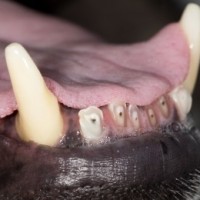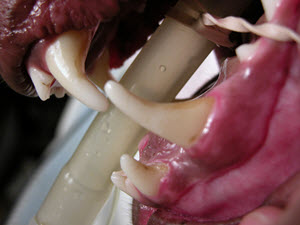Some tooth wear is expected, but in some situations the wear can be extreme, resulting in an abnormal loss of the top layer of the teeth. This is called attrition. Excessive wear of pet teeth can actually cause problems, and there are many reasons this can occur in dogs and cats. Some of the most common causes of worn pet teeth are chewing on tennis balls and other toys as well as itching/chewing as a result of skin allergies.

Both hair and (tennis) balls are very abrasive and can cause severe wearing of the incisor and canine teeth (and occasionally the premolars too). You can think of hair and tennis balls as a Brillo pad. Tooth wear can progress all the way to the gum line, and occasionally even below that.
Another cause of severely worn teeth is chewing on things like fences, which wears down the backside of the canines and increases the risk of tooth fracture. Finally, malocclusion or bite problems (i.e jaws that are not aligned properly, as in the photo to the right) can cause two teeth to come together and to wear on each other.
Worn pet teeth can look like fractured teeth, but the edges and tips are generally smooth. If the wear occurs slowly, the tooth may respond by laying down extra tooth structure (dentin) in response to the tooth loss to protect the root canal (nerve). If this occurs, the tooth will generally stay alive, and may not require any therapy. The exposed dentin in the middle of the tooth will become stained and it usually appears as a light tan to medium brown color. Furthermore, when a protective layer of dentin is present, a dental explorer instrument will not be able to enter the root canal when performed on oral exam. In contrast, if the root canal is not protected, an explorer will sink into the root canal during probing/examination.

In cases where the tooth is actually broken, or the wear occurs too fast or continues too far down to the gum line, the root canal is exposed and the tooth will become infected. Teeth with exposed root canals will generally have a dark brown to black center, as opposed to the light tan or medium brown color of reparative dentin, and which will allow an instrument into the canal. Teeth with direct root canal exposure are infected and require either root canal therapy or extraction.
On occasion, wear can occur quickly enough to infect the tooth, but the tooth lives long enough to lay down a protective layer of dentin before it dies. These teeth will look like a living, worn tooth on the outside, but are dead on the inside. The only way to tell for sure is by taking a dental x-ray. Dead teeth have wider root canals than their vital neighbors. For this reason, we recommend dental x-rays on all significantly worn teeth. For more information, talk with your veterinarian in Markham—your key resource for information about the health and well-being of your best friend.
If you found this blog informative, please share it with your friends on Facebook . Please call us (905)477-2323 for any questions or search for more articles on our website: http://unionvet.ca/resources/client-education/
Sincerely,
Dr. Ernst Marsig, veterinarian in Markham
Practicing Veterinary Medicine in Markham for a Long and Happy Life of ALL Your Pets.
Animal Hospital of Unionville, a veterinary clinic on the north side of Hwy 7, serving all pets in Markham, Richmond Hill, Scarborough, Stouffville, and North York since 1966. We are your family vets for dogs, cats, pocket pets (rabbits, chinchillas, gerbils, mice, rats, hamsters, guinea pigs, skinny pigs, etc.), ferrets, and birds (budgies, cockatiel, parrots, amazon, cockatoo, love birds, conures, African greys, finches, canaries, etc.).
Disclaimer: No part of this website constitutes medical advice. Readers are advised to consult with their veterinarian.

